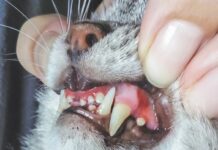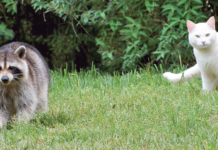Pumpkins, big, usually orange squashes, are everywhere this time of year. While many families simply think of pumpkins as the fruit they carve for Halloween, pumpkin can be a useful food for your cat.
Pumpkin is an excellent source of potassium—a mineral that is important for a variety of physiologic functions. It also contains calcium, iron, and vitamins A, C, and E. It has three to five grams of fiber per cup of pureed pumpkin and, just as with people, fiber can help with constipation in your cat. The bulk stimulates the gastrointestinal walls to contract and can help move along simple obstructions, such as hairballs.
Paradoxically, pumpkin can also help with diarrhea, especially large-bowel diarrhea. The fiber draws in excess fluid, firming up stools. If you want to use pumpkin as an aid for diarrhea or constipation, start with a half to one teaspoon, but be careful when you determine how much to add. You don’t want to tip your pet from one extreme to the other.
For a cat packing on some extra pounds, pumpkin can help in a weight-loss program. Adding a half to one teaspoon of pumpkin to her meal means less calories but a still-satisfying meal, although you should discuss exactly how much with your veterinarian.
It’s important when considering feeding pumpkin to look for plain canned pumpkin at the supermarket. Check ingredients carefully. Pumpkin should be the only ingredient—not pie-filling canned pumpkin, which has spices and other items, such as sugar, added. Not only does your pet not need those additives, they may make them feel ill.
You can cook and puree your own pumpkin and then can or freeze it as well. Pumpkin ice cubes make nice treats for warm weather. Simply fill an ice cube tray with freshly pureed pumpkin or spoonfuls of plain canned pumpkin. Do not feed your Halloween jack o’ lantern post-holiday—many of these have mold developing on the inside. Raw pumpkin is not recommended either. Of course, always consult with a veterinarian prior to giving your cat pumpkin.
Surgery Margins for Feline Injection-Site Sarcoma
In the early 1990s, an association between injection sites and feline sarcoma—a cancer of the connective and soft tissues—was established. Although the cancer is rare, it’s believed to be due to an inflammation at the vaccine site. Exactly why remains a mystery, but cats who still have a lump at the vaccine site a month after an injection should be examined by a veterinarian.
Injection-site sarcoma is an aggressive cancer. The tumor is most commonly treated by surgical removal it, followed by radiation. Removing too small an area could leave cancer cells behind, but taking too large of an area makes post-operative healing more difficult. Researchers at Oregon State University (OSU) have begun looking for the optimal surgical margin. The pilot study was published in the January 2017 publication Veterinary Surgery.
“If we can understand the relationship between what the pathologist sees on a slide under a microscope and what the surgeon is taking out in the operating room, and what accounts for the differences between the two, then we can work backward and figure out how much surgical margin to take,” says Milan Milovancev, a board-certified veterinary surgeon at the OSU’s College of Veterinary Medicine.



